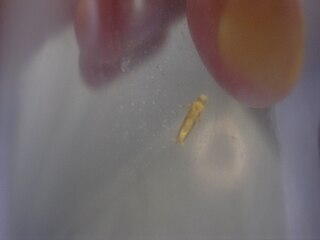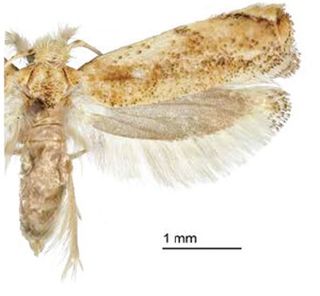Comodica is a small genus of the fungus moth family, Tineidae. Therein, it belongs to the subfamily Erechthiinae. It is apparently a close relative of the type genus of its subfamily, Erechthias.

Erechthias is a genus of the fungus moth family, Tineidae. Therein, it belongs to the subfamily Erechthiinae, of which it is the type genus. The exact circumscription of this genus is still disputed, but it may encompass more than 150 species.
Anatrachyntis rileyi, the pink cornworm, pink bud moth or pink scavenger, is a species of moth of the family Cosmopterigidae, the cosmet moths. It was first described by Lord Walsingham in 1882 from the southern United States, but it is probably an introduction to North America. It is found in much of the warm or tropical areas of the world, including northern Australia, the Galápagos Islands, Hawaii, the Antilles, South America and Mauritius.
Crypsithyrodes concolorella is a moth of the family Tineidae. It was first described by Francis Walker in 1863. It has been recorded from Australia, French Polynesia, the Seychelles, Fiji, Hawaii, Java, Rennell Island, the Caroline Islands and Malaya.
Praeacedes is a monotypic moth genus in the family Tineidae first described by Hans Georg Amsel in 1954. Its only species, Praeacedes atomosella, was first described by Francis Walker in 1863. It has a wide range and has been recorded from Europe, Australia, Hawaii, India, Malaysia, Solomon Islands, Rapa, Mauritius, Madagascar, Réunion, South America and North America. The species has commonly been misidentified in various parts of the world.
Phereoeca allutella, the household case-bearing moth, belongs to the subfamily Tineinae of the fungus moth family (Tineidae). It was first described by Hans Rebel in 1892. It is an occasional pest of furs, flannel and similar materials, and has been inadvertently introduced to many places it is not originally native to.
Trichophaga mormopis is a moth of the family Tineidae. It was first described by Edward Meyrick in 1935. It is widely distributed from Africa to India, Sri Lanka, Malaya, Taiwan and Fiji. It was first recorded from Hawaii in 1944.

Monopis crocicapitella, the pale-backed clothes moth, is a moth of the family Tineidae described by James Brackenridge Clemens in 1859. It has a nearly cosmopolitan distribution. It was first described from the eastern United States. It is particularly destructive of fabric and clothes. A study undertaken on eleven English Heritage properties over several years before the winter of 2017-2018, showed that the number of moths captured in traps increased significantly during the study period.

Monopis meliorella, the blotched monopis moth, is a moth of the family Tineidae. It was first described by Francis Walker in 1863. It has been recorded from Australia and Hawaii.
Dryadaula advena is a moth of the family Tineidae. It was first described by Elwood Zimmerman in 1978. It has only been recorded from Hawaii, but might be an immigrant.
Erechthias flavistriata, the sugarcane bud moth, is a moth of the family Tineidae. It was described by Lord Walsingham in 1907 from Hawaii, but is probably an introduced species. It is found in large parts of the Pacific Rim including the Marquesas, Rapa Iti, Fiji, the New Hebrides, the Kermadec Islands, the Solomons, Java and Malaya. It has been spread widely by man and probably has travelled to many islands throughout much of the Pacific in the canoes of the native peoples.

Erechthias minuscula, the erechthias clothes moth, is a moth of the family Tineidae. It was first described by Lord Walsingham in 1897. It is widespread and has been recorded from Africa, Sri Lanka, Java, Australia, the Caroline Islands, Fiji, Samoa, the Marquesas, the West Indies, Hawaii and Florida.
Erechthias penicillata is a moth of the family Tineidae. It was first described by Otto Herman Swezey in 1909. It is found in the Pacific region, including French Polynesia and Hawaii.
Erechthias kerri is a moth of the family Tineidae. It was first described by Otto Swezey in 1926. It is found in the Pacific region, including the French Frigate Shoals, Lisianski, Laysan, the Pearl and Hermes Reef, Johnston Island and Hawaii.

Erechthias simulans is a species of fungus moth. It is here considered to belong to the somewhat controversial type genus of its subfamily Erechthiinae, though even fairly recently some authors have proposed to retain other genera such as Decadarchis separate from Erechthias. Decadarchis, with E. simulans as type species, would in fact contain this moth and its closest relatives, regardless whether it is recognized as full genus or as subgenus. These relatives are generally held to be a group of mainly Polynesian species. E. simulans has also been mistaken for a species of the closely related genus Comodica; while the delimitation of this versus Erechthias/Decadarchis is not universally agreed upon, E. simulans is not included in Comodica anymore by modern authors.
Erechthias zebrina is a fungus moth. Initially, it was mistakenly believed to be an ermine moth of genus Argyresthia.
Setomorpha is a monotypic moth genus in the family Tineidae described by Philipp Christoph Zeller in 1852. Its only species, Setomorpha rutella, the tropical tobacco moth, was described by the same author in the same year. It is a widely spread species that has been distributed by commerce over much of the warmer parts of Africa, Eurasia, Malaysia, Australia, many Pacific islands and North and South America.

Lindera is a monotypic moth genus in the family Tineidae described by Blanchard in 1854. Its only species, Lindera tessellatella, was described by the same author two years earlier. It is a widely distributed species, which was first described from South America, but has been recorded from Africa, Europe, North America, Australia, New Zealand, Fiji and Hawaii.
Opogona purpuriella is a moth of the family Tineidae. It was first described by Otto Swezey in 1913. It has been recorded from Hawaii and Tonga. It has also been reported as a port interception in California.

The Erechthiinae are a subfamily of moth of the family Tineidae.







